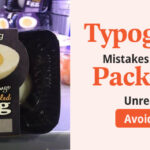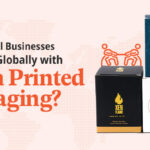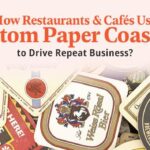Typography Mistakes That Make Packaging Unreadable-Avoid Them
Typography on product packaging should be readable, interesting, and useful for conveying ideas rather than just being aesthetically pleasing.
A brand can invest thousands of dollars in exquisite packaging design, but it will be in vain if consumers are unable to read the content.
Unbelievably frequently, typography mistakes on packaging can seriously detract from the customer experience.
The most frequent typographical errors that render packaging unreadable will be discussed in this blog, along with tips for avoiding them.
5 Typography Mistakes that Should be Avoided
1. Choosing Fonts That Don’t Match the Brand Identity
Choosing a font that doesn't convey the personality of the brand is one of the most common typographic errors.
Wouldn't it be confusing if a high-end perfume company used a cartoonish font? In addition to causing brand inconsistency, using the incorrect typeface gives the packaging an amateurish appearance.
Your brand voice should be reflected in your font. For instance:
- Elegant serif fonts are frequently used by luxury brands.
- Clean sans-serif fonts may be more common in modern tech products.
- Organic, handwritten fonts are frequently used in eco-friendly products.
Always ask yourself: Does this font represent our brand? If not, it's time to reconsider.
2. Putting Too Many Fonts
Potential customers are sure to become confused by a cluttered design. Using three or more different fonts on one package is a common mistake made by brands.
Despite its apparent inventiveness, it frequently produces a visual jumble that detracts from the message.
The rule of gold? Limit yourself to two fonts that go well together:
- One for brand names or headings.
- One for product details or body text.
This thing makes it easy for customers to read without sacrificing aesthetic appeal.
3. Poor Font Size Selection
Choosing the right font size can make all the difference! Picture this: you’re trying to decipher those tiny nutrition facts on a snack pack super annoying, right?
One of the most common blunders in packaging design is opting for fonts that are just too small. On the other hand, if the fonts are oversized, it can throw the whole design off balance.
Here’s a quick rundown:
Brand name: Go big and bold for instant recognition.
Tagline or key benefit: A bit smaller, but still easy to spot.
Ingredients/nutrition info: Clear enough to read without straining your eyes.
Always give your design a test run by holding the packaging at arm’s length. If you can’t easily read the important details, it’s time to tweak that font size!
4. Ignoring Contrast Between Text and Background
One significant readability problem arises from poor color contrast. Imagine trying to read white text on a yellow background or black text on a dark blue label it’s almost impossible!
Not only does poor contrast hurt the overall look, but it also fails to meet accessibility standards, which can drive customers away.
To improve this:
- Opt for light text on dark backgrounds and dark text on light backgrounds.
- Steer clear of placing text over busy patterns without a solid backdrop.
- Test your packaging in various lighting situations.
Keep in mind: good contrast equals clear communication.
5. Overly Decorative Fonts
We totally understand decorative fonts can be fun and stylish. However, when they’re overused, they can turn into a legibility nightmare.
Fonts that are overly ornate, with too many flourishes, swirls, or odd letter shapes, might look fantastic in a logo but are a poor choice for body text.
Ask yourself: Can a customer read this in under three seconds? If the answer is no, it’s time to switch to something simpler. Save decorative fonts for accents or logos, and keep the main text clean and easy to read.
Final Thoughts!
Typography is a key player in the world of packaging design. Choosing the wrong font, size, or contrast can make your product details difficult to read, which can frustrate customers and ultimately hurt your sales.
By steering clear of common typography mistakes like using mismatched fonts, tiny text, or poor contrast—you can make sure your packaging box not only looks fantastic but also gets your message across clearly.
Great packaging design isn’t just about grabbing attention; it’s also about ensuring clarity, readability, and consistency with your brand. Nail the typography, and you’ll see an immediate boost in your product’s appeal on the shelf.




